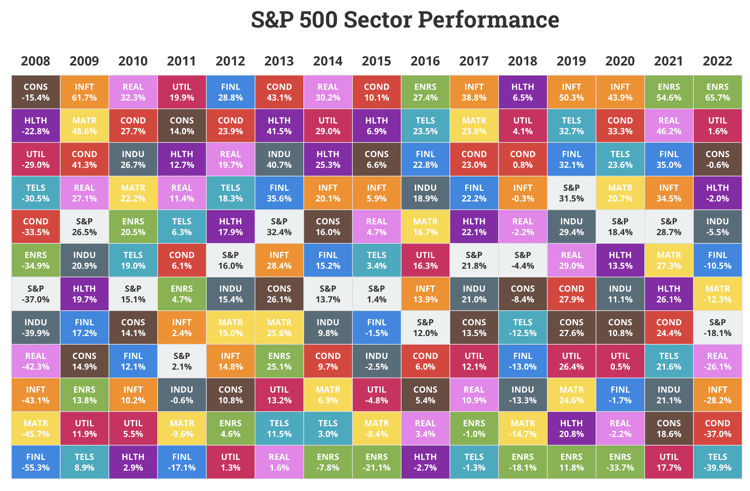Sports betting has gone mainstream. But that doesn’t mean it’s easy. While some people may, on occasion, win a single game, when they parlay several games, the odds of winning are reduced exponentially.
Stock selection is similarly as hard. While an investor may get one or a few stocks right, selecting a portfolio of winners is not as easy.
That’s because market leadership is not static
Just look at the chart below. We know, there are a lot of colors! But as they say, a picture tells a thousand words.
In order of best to worst performing, this chart ranks all of the market sectors represented in the S&P 500 compared to the S&P 500 index itself, for the last 15 years through December 31, 2022.
 Source: novelinvestor.com. Past performance does not guarantee future returns. The historical performance is meant to show changes in market trends across the different S&P 500 sectors over the past ten years. Returns represent total annual returns (reinvestment of all distributions) and does not include fees and expenses. The investments you choose should reflect your financial goals and risk tolerance. For assistance, talk to a financial professional. All data are as of 12/31/22.
Source: novelinvestor.com. Past performance does not guarantee future returns. The historical performance is meant to show changes in market trends across the different S&P 500 sectors over the past ten years. Returns represent total annual returns (reinvestment of all distributions) and does not include fees and expenses. The investments you choose should reflect your financial goals and risk tolerance. For assistance, talk to a financial professional. All data are as of 12/31/22.
No, your eyes are not deceiving you! Sector winners are all over the map. For example, in 2018, healthcare was the top dog, but then in 2019, it was trolling near the bottom of the chart. Energy was the winner last year, and the year before, but it was the biggest loser according to this chart for the past three years from 2018 to 2020. The takeaway? There’s no discernable pattern.
So while the chart makes a lovely colorful quilt, it doesn’t exactly inspire confidence that picking the right sector will help drive long-term portfolio growth and minimize volatility.
But how can an active ETF manager create a fund that has the potential to perform well while considering sector rotation and market volatility?
Bottom-up fundamental analysis can be key
Unlike sports betting, which has many uncontrollables, finding what we believe is a Quality company is about doing your homework. Our active portfolio management team has developed a repeatable investment process that analyzes and scores companies using our Four Pillars of Quality framework:
- Management, culture, and incentives
- Economics
- Competitive advantages
- Trajectory
That doesn’t mean that we get every security selection right—no one does. But it does mean that we pick our investments based on individual company dynamics and their interplay with consumers, competitors, and the overall economy.
So even if overall sector returns are all over the map—as they tend to be—it often doesn’t matter to us because we strive to construct our portfolios with Quality companies and volatility minimization in mind, regardless of in which sector they may fall.
Related Posts

Lessons from Legendary Value Investors That May Still Work
Many trends in investing seem to come and go, but to us value investing is a philosophy that has...

Deck the Halls with Tough Decisions

Mann on the Street
It doesn’t seem like there should be seasonality in investing—after all, businesses are businesses...

Fundamental Forces: Making Sense of Gravity in Today’s Market

McFaddin on the Markets
When I was in college, one of the things that drew me to economics and mathematics was the nature...
Interested in more?
Get our popular newseltter delivered to your inbox every month.
Search the Insights Blog
How to invest with us
Click the button below to learn how you can get started with Motley Fool Asset Management








